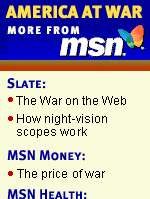

 |  |
 |
NBC NEWS AND NEWS SERVICES | |||||
| April 7 — The U.S. military is testing samples from a site in Iraq where soldiers found possible chemical weapons, defense officials said Monday. Embedded journalists in Iraq reported instances where banned weaponry was found, including on some 20 rockets armed with warheads containing deadly sarin and mustard gas that were apparently ready to fire. | |||||
|
|
TESTING AT laboratories in the United States has to be completed before the presence of chemical weapons could be confirmed, the officials said. If the discoveries were confirmed, it would be the first find of chemical weapons during the war. Finding and eliminating Saddam Hussein’s chemical and biological weapons is a goal of the U.S.-led invasion of Iraq, and the discovery of such weapons of mass destruction could mute international criticism of the war. Iraq acknowledged making tons of sarin, tabun, mustard gas and other chemical weapons. Iraq used mustard gas and sarin against Iran during the 1980-88 Iran-Iraq war and is believed to have used the chemicals against Kurdish Iraqis. Sarin and tabun are related nerve agents that can kill when absorbed through the skin or inhaled as a gas. They kill by causing convulsions, paralysis and asphyxiation. Mustard gas begins dissolving tissue on contact and is particularly harmful to eyes and lungs. It does not usually kill but causes painful injuries that can linger for a lifetime. One senior intelligence official told NBC that the reports of chemical weapons should be treated with caution, noting that previous suspicions proved to be unfounded. “Often the first test is wrong, the second as well,” the official said, speaking on condition of anonymity. “And believe me, if it turns out to be chemical weapons, you won’t miss the story.” |
|||||||||||||||||||||||||||||||||||||||||||||||||||||||||||||||||||||||||||||||||||||||
|
|
VARIOUS REPORTS Since the war’s onset on March 20, a number of reports that suggested the presence of banned weaponry turned out to be wrong. However, on Monday several reporters gave accounts of discoveries that could boost the U.S. argument, emanating from officers with Army and Marine divisions. A Knight Ridder News Service journalist traveling with the the Army’s 101st Airborne Division reported about suspicious material in a compound near the Iraqi city of Hindiyah, about 60 miles south of Baghdad. Reporter Tom Lasseter said initial tests of samples from the facility were inconsistent. Some tests did not indicate chemical weapons, while others indicated the presence of G-class nerve agents — which include sarin and tabun — and mustard agent, a blistering chemical first used in World War I. He also reported that he and several soldiers were decontaminated after some of the soldiers felt ill while searching the compound. Officials at the Pentagon said they did not have any information about anyone getting sick. NBC’s Dana Lewis reported from near Karbala that U.S. Army commanders said they have discovered more than a dozen barrels of chemicals in an agricultural facility 30 miles northeast of there that have tested positive as blister and nerve agents. It wasn’t immediately clear whether Lewis and Lasseter had been provided with details on the same alleged chemical dump. |
|||||||||||||||||||||||||||||||||||||||||||||||||||||||||||||||||||||||||||||||||||||||
|
|
ON WARHEADS? Meanwhile, National Public Radio reporter John Burnett said officers of the U.S. 1st Marine Division told him warheads had been found south of Baghdad in a warehouse near Baghdad International Airport, seized last week by coalition forces. The officers told him the warheads were on Iraqi BM-21 unguided rockets. Those rockets are about 10 feet long, with a range of approximately 15 miles. The BM-21 is a 40-year-old truck-mounted system with 40 rocket tubes, intended for close support of troops. |
|||||||||||||||||||||||||||||||||||||||||||||||||||||||||||||||||||||||||||||||||||||||
Separately, The Wall Street Journal reported that U.S. military officers had told troops that soldiers from the 101st Airborne Division had captured an Iraqi BMP Armored Personnel Carrier that was believed to contain sarin gas and mustard gas. That information was issued over the military secure radio network, according to several Marine officials who heard the broadcast at about 11 a.m. local time. They relayed the advisory to a reporter who was standing with them. The radio advisory included no other details, including how much of the material was found or where the discovery occurred. BARRELS HIDDEN IN A PIT NBC’s Lewis reported that U.S. commanders were led to the agriculture facility by an Iraqi. As they were searching through the agricultural facility they discovered literature on controlling mosquitoes. But in a nearby pit camouflaged with leaves they found eleven 25-gallon barrels and three 55-gallon barrels. | ||||||||||||||||||||||||||||||||||||||||||||||||||||||||||||||||||||||||||||||||||||||||
|
Initial tests at the site were positive for chemical weapons, so more sophisticated gear — a mobile testing unit provided by the German government — was brought in. Those tests also were positive for GA, known as tabun, GB, also known as sarin, both nerve agents, and for lewisite, a blister agent. But further testing is under way. “Our detectors have indicated something,” Maj. Ros Coffman, a public affairs officer with the U.S. 3rd Infantry, told Reuters. |
|||||||||||||||||||||||||||||||||||||||||||||||||||||||||||||||||||||||||||||||||||||||
NBC’s Dana Lewis, traveling with the U.S. 101st Airborne in Iraq, The Associated Press and Reuters contributed to this report. | ||||||||||||||||||||||||||||||||||||||||||||||||||||||||||||||||||||||||||||||||||||||||
|
||||||||||||||||
|
||||||||||||||||
|
||||||||||||||||
|

